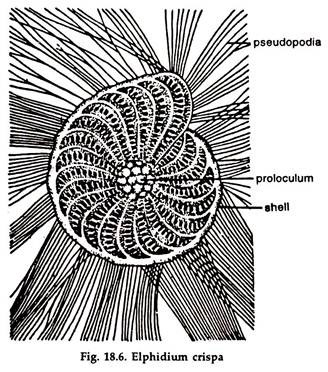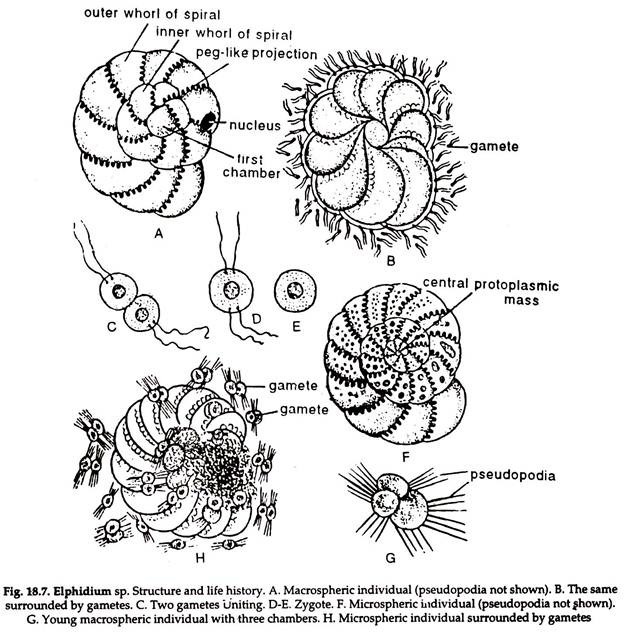In this article we will discuss about the structure and life history of elphidium, explained with the help of suitable diagrams.
Structure of Elphidium:
1. The shape of the animal is more or less round.
2. It is surrounded with a many-chambered, mullilocular and perforate calcareous shell consisting of 45 to 50 chambers.
ADVERTISEMENTS:
3. The, chambers are boat-shaped and spirally arranged and each completely covers its predecessor. They communicate with each other through minute pores or foramen.
4. The margins of the shells are provided with’ peg-like projections. The shell bears a keel and the last chamber has a terminal aperture.
5. The chambers are filled up with cytoplasm, which passes through the openings in the septa; the cytoplasm of the whole body of the animal is not divided into compartments but it is continuous. Nucleus may be one or many. The cytoplasm extends through the pores of the shell to form a layer over the shell.
6. Long, slender pseudopodia project outside through the minute pores present all over the shell and also through the terminal aperture; they often branch and anastomose with one another. Pseudopodia are of reticulate type, i.e. narrow, almost thread-like, branched and continually anastomose.
ADVERTISEMENTS:
7. The adult Elphidium is dimorphic, some are Schizonts or Agamonts, commonly known as microspheric individual, characterised by an initial central chamber or pro-loculus of relatively minute size, and some others are gamonts, more commonly known as macrospheric individual, which give rise to gametes, characterised by a large centrally placed chamber.
Life History of Elphidium:
Elplndium reproduces by both asexual and sexual modes. A well-marked alternation of generations is always present. The mode of reproduction in different species is not identical.
ADVERTISEMENTS:
The following description is applicable to Elphidium crispa (Fig. 18.7C-H):
Formation of macrospheric individuals:
The microspheric form acts as a schizont or agamont which gives rise to the macrospheric form by a process of schizogony or multiple fission.
1. With the growth of the animal, the number of nuclei in the microspheric individual increases by division and gives off chromidia to the body protoplasm.
2. With the commencement of reproduction the nuclei resolve into chromidia and the protoplasm leaves the shell, which is abandoned altogether.
3. The chromidia-laden protoplasm breaks up into a large number, about 200 amoeboid agametes or amoebulae or pseudopodiospores.
4. Each pseudopodiospore bears a number of chromidial granules, which fuse to form a nucleus and secretes a single-chambered shell, the initial chamber of a macrospheric individual.
5. Each amoebula feeds, grows, secretes new chambers successively and becomes a macrospheric adult.
ADVERTISEMENTS:
Formation of microspheric individuals:
1. A single nucleus (the original nucleus of amoebula) is present in the full-grown macrospheric individual.
2. The nucleus of the gamont moves from chamber to chamber and then follows a complicated nuclear reorganization, when the primary nucleus is seen to have completely resolved into (chromidia?) a number of secondary nuclei. In some cases, it undergoes sporulation into a multitude of minute (2-5 µm) biflagellate isogametes, which are set free and escape outside the shell.
3. The gametes are of different sizes, produced by different individuals and bear unequal flagelia.
4. The unequal gametes fuse in pairs, lose the flagella and the zygote is formed, which secretes a single-chambered shell around it, and the microspheric individual is produced.
Alternation of Generations:
An alternation of generations in the life history of Elphidium is quite distinct. The microspheric form gives rise to the gametocytes (macrospheric) by multiple fission. The gametocytes in turn produce gametes, which by their union form the zygotes and, thereby, the microspheric individual is formed, and the two generations alternate with each other.
The usual mode of reproduction may be stated in the following way. When ‘m’ represents microspheric individual; am = amoebula; ‘M’ = Macrospheric individual, ‘fl’ = flagellula, → m → am → M →(fl + fl) → m ……….
Sometimes this normal cycle may be disturbed when a number of asexual generations are repeated before a sexual generation interferes.
This may be stated in the following way:
m → am → m → am → M (fl + fl) → m….


